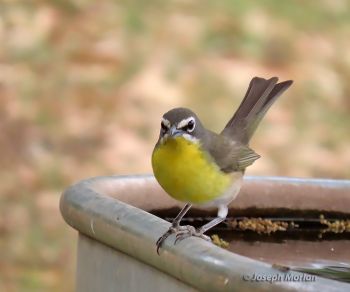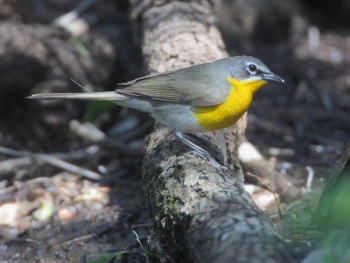- Icteria virens
Identification
19cm
Olive upperparts, white belly, yellow throat and breast, long tail, thick heavy bill, large white eye-ring, and dark legs.
Distribution
Breeds in USA, western half of southern Canada and northern Mexico. Recent results suggest that at least part of the US population after having bred in early parts of summer migrates to north-western Mexico where a second round of breeding takes place before the birds go on the final migration to their winter home.
In winter found in Mexico (mostly southern half) though Central America to Panama.
Taxonomy

Photo © by Joseph Morlan
Concan, Texas, USA, 14 April 2021
Subspecies

Photo © by bobsofpa
Sam Nail Ranch, Big Bend National Park, Texas, USA, April 2010
Two subspecies are recognized[1]:
- I. v. virens: Eastern
- I. v. auricollis: Western
- Southern British Columbia to Baja and northern Mexico; winters to Guatemala
Habitat
Dense brush and hedgerows.
Behaviour
Breeding
The cup-shaped nest is hidden in thick shrubs.
Diet
The diet consists mostly of insects with fruit and berries added, particularly during the autumn months.
References
- Clements, J. F., T. S. Schulenberg, M. J. Iliff, S. M. Billerman, T. A. Fredericks, B. L. Sullivan, and C. L. Wood. 2019. The eBird/Clements Checklist of Birds of the World: v2019. Downloaded from http://www.birds.cornell.edu/clementschecklist/download/
- Paper describing migration to second breeding area
- Eckerle, K. P. and C. F. Thompson (2020). Yellow-breasted Chat (Icteria virens), version 1.0. In Birds of the World (A. F. Poole and F. B. Gill, Editors). Cornell Lab of Ornithology, Ithaca, NY, USA. https://doi.org/10.2173/bow.yebcha.01
- Wikipedia
Recommended Citation
- BirdForum Opus contributors. (2025) Yellow-breasted Chat. In: BirdForum, the forum for wild birds and birding. Retrieved 16 May 2025 from https://www.birdforum.net/opus/Yellow-breasted_Chat
External Links
GSearch checked for 2020 platform.1





